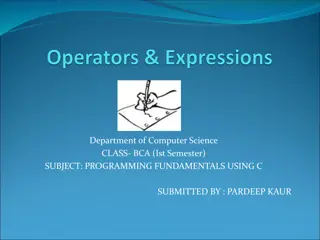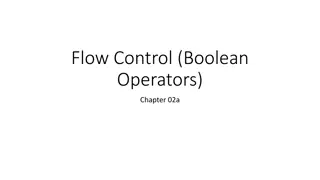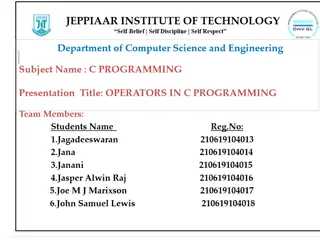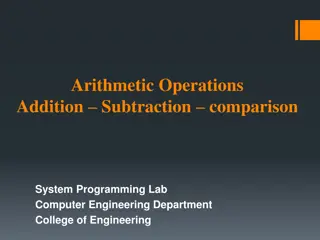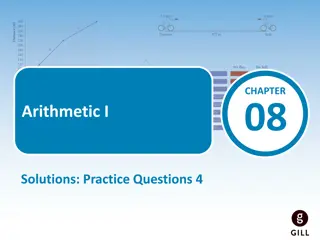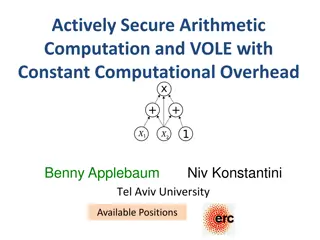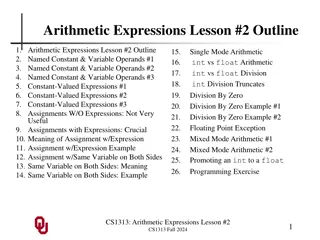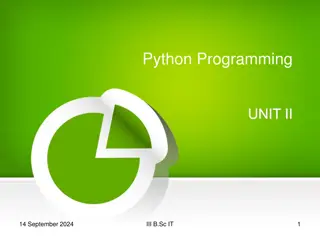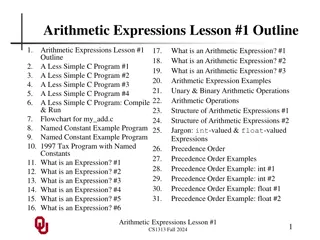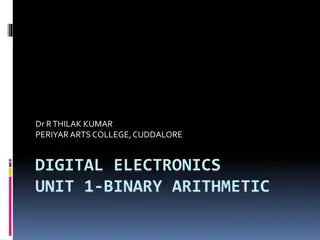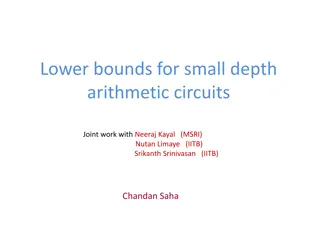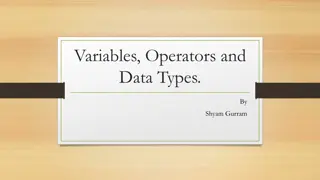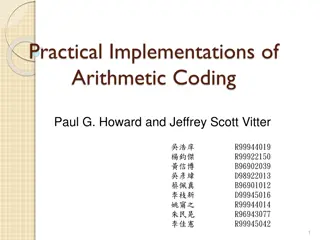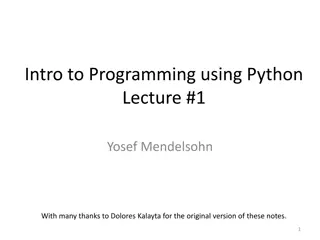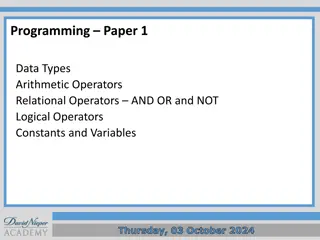C++ Arithmetic Operators
In this learning material, you will delve into the realm of C++ arithmetic operators. Explore the different groups of operators such as arithmetic, assignment, increment/decrement, relational, and logical. Dive into examples illustrating the usage of arithmetic operators in C++ expressions. Discover the importance of specifying multiplication explicitly and mastering operator precedence. Enhance your understanding of writing mathematical formulas in C++ with practical examples.
Download Presentation

Please find below an Image/Link to download the presentation.
The content on the website is provided AS IS for your information and personal use only. It may not be sold, licensed, or shared on other websites without obtaining consent from the author.If you encounter any issues during the download, it is possible that the publisher has removed the file from their server.
You are allowed to download the files provided on this website for personal or commercial use, subject to the condition that they are used lawfully. All files are the property of their respective owners.
The content on the website is provided AS IS for your information and personal use only. It may not be sold, licensed, or shared on other websites without obtaining consent from the author.
E N D
Presentation Transcript
1 King Saud University College of Applied studies and Community Service Csc 1101 By: Asma Alosaimi Edited By: Ghadah R. Hadba CHAPTER 2 PART #4 OPERATOR 2ndsemester 1432 -1433
Operators 2 Operators are special symbols used for: arithmetic calculations assignment statements logical comparisons Examples of operators: 3 + 5 // uses + operator 14 + 5 4 * (5 3) // uses +, -, * operators Expressions: can be combinations of variables and operators that result in a value
C++ Operators 3 In C++, there are 5 different groups of operators: Arithmetic Operators Assignment Operator Increment / Decrement Operators Relational Operators Logical Operators
C++ Operators: Arithmetic Operators 5 The arithmetic operators in Fig. 2.9 are all binary operators, i.e. operators that take two operands Each operand can be either a literal ,a variable identifier , oran expression. It is better for the two operands to be of the same data type, otherwise: The compiler will perform implicit casting (with literal values) and/or, Explicit casting need to be specified (with variables) Note the use of various special symbols not used in algebra.( e.g. * and %)
Writing Mathematical Formulas in C 6 Always specify multiplication explicitly by using the operator * where needed. Example: b - 4 a c = b * b - 4 * a * c Use parentheses when required to control the order of operator evaluation. Example: a + b = c + d ( a + b ) / ( c + d ) Two arithmetic operators can be written in succession if the second is a unary operator Example: a x - ( b + c )= a * - ( b + c ) C Language Elements
Writing Mathematical Formulas in C++ (Examples) 7 a + b - c = a + b - c 1 = 1 / ( 1 + a * a) 1 + a a x (5b + c) = a * ( 5 * b + c ) C Language Elements
Parentheses 10 The value of the expression x + y * z * z is always the same as the value of x + ((y * z) * z)
Rules for Expression Evaluation (Examples) 11 z - ( a + b / 2 ) + w * - y ( b * b ) - ( 4 * 4 ) * ( a * c ) A * - ( b + c ) C Language Elements
Division Example 12 Exampleof division issues: 10 / 3 gives 3 10.0 / 3 gives 3.33333 As we can see, if we divide two integers we get an integer result. if one or both operands is a floating-point value we get a floating-point result. If the operands are from different data type, especially dividing floating-point number by an integer or vice a versa the result will be a floating-point number
Modulus Example Page 13 Generates the remainder when you divide two integer values. 5%3 gives 2 5%4 gives 1 5%5 gives0 5%10 gives 5 Modulus operator is most commonly used with integer operands. If we attempt to use the modulus operator on floating-point values we will garbage! (compileerror)
C++ Operators: Arithmetic Operators 14 Implicit casting: is an automatic type conversion by the compiler. If operands of mixed types are used, the compiler will convert one operand to agree with the other. To do this, it uses a hierarchy of data types: Long double (highest) Double Float Unsigned long int Long int Unsigned int Int (lowest) boolean, character, wide character, enumeration, and short integer data types are promoted to int
C++ Operators: Arithmetic Operators 15 Implicit casting: Example(1): 5+23.67 The compiler will converts 5 to floating point number because it s higher than int in the data type hierarchy Example(2): short a=2000; int b; b=a; the value of a has been promoted from short to int Example(3): bool f=true; int a; a=f; cout<< a<<endl;
C++ Operators:Assignment Operator 16 We assign a value to a variable using the basic assignment operator (=). Assignment operator: Stores a value in a memory. Basically used in C++ to initialize a variable with a value OR to update it s content with a new value It s syntax is as following leftSide = rightSide ; It is always a variable identifier. It is either a literal ,a variable identifier , oranexpression.
Mixed Data Types in an Assignment Statement 17 The variable to the left of the equals sign determines the data types of an expression. If both operands of an expression are integer then the data type of such an expression will be integer. If both operands of an expression are double then the data type of such an expression will be double. An expression that has operands of both type integer and double is a mixed-type expression. The data type of such a mixed-type expression will be double. C Language Elements
Mixed Data Types in an Assignment Statement 18 Example: if x is int and y is double then x = 7 * 0.5; 3 y = 7 * 0.5; 3.50 x = 100/5; 20 y = 100/5; 20.00 C Language Elements
C++ Operators: 19 Explicit casting: Performed by placing (data type) prior the intended variable|value|expression Example(1): short a=2000; int b; b = (int) a; Example(2): intvalue1 = 10, value2 = 4; floatresult = (float) (value1 / value2); OR result= (float) value1/(float) value2; are they the same?
C++ Operators: Type CastExplicit casting: converting an expression to a different type by writing the desired type in parentheses in front of the expression or the variable. Example: Rounding a number double x; int rounded_x /* code to give x a value omitted*/ rounded_x = (int) (x + 0.5); 35.51 is rounded to 36 35.12 is rounded to 35 35.51 +0.50 36.01 35.12 +0.50 35.62 20
Compound Assignment Operators 21 When we want to modify the value of a variable by performing an operation on the value currently stored in that variable we can use compound assignment operators C++ allows combining arithmetic and assignment operators into a single operator as following: Addition/assignment += Subtraction/assignment Multiplication/assignment = Division/assignment /= Remainder/assignment %= =
Compound Assignment Operators 22 The syntax is It is either a literal ,a variable identifier , or anexpression. leftSide Op= rightSide ; Allways it is a variable identifier. It is an arithmetic operator. This is equivalent to: leftSide = leftSide Op rightSide ; Example X+=1 x=x+1; x%=5; x*=y+w*z; x = x % 5; x = x*(y+w*z);
C++ Operators: Increment/Decrement Operators 24 ++ and are a unary operators that can be applied to variables and increments/decrements the value they hold x++/++x; is equivalent to x = x+1; x--/--x; is equivalent to x = x-1;
C++ Operators: Increment/Decrement Operators 25 Placing the increment/ decrement operator before the variable name differ from placing it after as following:
C++ Operators: Increment/Decrement Operators 26 Placing the increment/ decrement operator before the variable name differ from placing it after as following (Example):
C++ Operators: Equality and Relational Operators 28
C++ Operators: Equality and Relational Operators 29 In order to evaluate a comparison between two expressions we can use the relational and equality operators The relational and equality operators operators in Fig. 2.12 are all binary operators, i.e. operators that take two operands Each operand can be either a literal ,a variable identifier , oran expression. The result of a equality and relational operations is a Boolean value that can only be true or false, according to its Boolean result.
Example 30 Of course, instead of using only numeric constants, we can use any valid expression, including variables. Suppose that a=2,b=3 and c=6
Common Programming Errors 31 A syntax error will occur if the operators ==, !=, >= and <= appears with space(s) between its pair of symbols A syntax error will occur when reversing the order of the pair of symbols!=, >= and <= (i.e. by writing them as =!, =>, =< respectively) Confusing the equality operator == with the assignment operator
C++ Operators: Logical Operators Page 32 Symbol Operator ! NOT && AND || OR && T T F || T T F ! T F T F T T F T F F F T F F
C++ Operators: Logical Operators Page 33 The Operator ! is an operator to perform the Boolean operation NOT it has only one operand located at its Basically, it returns the opposite Boolean value of evaluating its operand Example: !(5 == 5) // evaluates to false because the expression at its right (5 == 5) is true. !(6 <= 4) // evaluates to true because (6 <= 4) would be false.
C++ Operators: Logical Operators Page 34 The logical operators && and || are: binary operators used when evaluating two expressions to obtain a single relational result. The operator && corresponds with Boolean logical operation AND. The operator || corresponds with Boolean logical operation OR. Example:
Convert Text to C++ code English language: x less than or equal to 0 C++ language: (x<=0) English language: grade not equal to 'A' C++ language: (grade != 'A ) English language: an exam score of 90 and above or quiz score of 95 and above C++ language: (exam>=90) || (quiz>=95) English language: a single man whose 55 years old or older C++ language ((status=='s )&&(gender=='m ) )&&(age>=55))
Operator Precedence Page 36 Consider the following expression: x=y*5+y*2/4; Which operator the compiler will perform first?! IN C++, order of operations (sometimes called operator precedence) is a rule used to clarify unambiguously which procedures should be performed first in a given Note that parentheses () can be used to enforce a desired order for performing operations x=y*5+y; x=y*(5+y); 1 2 2 1
Figure A.1 show the decreasing order of precedence from top to bottom Precedence Operator Type Associatively 1 () Parentheses Left-to-right 2 ++, -- Prefix increment and decrement Right-to-left - Unary minus ! Logical NOT 3 (type) Type case Right-to-left 4 * , / , % Multiplication, division, and module Left-to-right 5 +,- Addition and subtraction Left-to-right 6 <<, >> Left-to-right 7 <, <=,>,>= Relational operators Left-to-right 8 ==, != Equality operators Left-to-right 9 && Logical AND Left-to-right 10 || Logical OR Left-to-right 11 +=,-=,*=/=,%= Right-to-left Page 37 12 ++, -- Postfix increment and decrement Left-to-right





